Sully, the Movie
Think about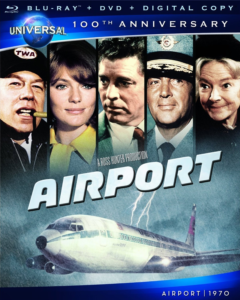 the last time you walked through an American airport, particularly one that is heavily domestic. Who were the pilots in uniform you saw strolling down the corridors pulling their leather flight bags?
the last time you walked through an American airport, particularly one that is heavily domestic. Who were the pilots in uniform you saw strolling down the corridors pulling their leather flight bags?
I’ll wager the vast majority were White males. That would make sense, since unlike most other professions today, piloting airplanes in America has remained in
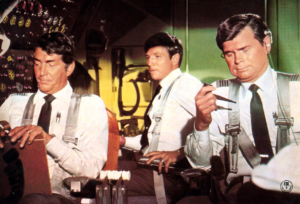
A Nice White Flight Crew; Airport (1970)
the vicinity of 95% White male. This must gall liberals, social engineers, and other SJW’s, for these groups dream of a world of equality, that is, one in which White males are purged, eliminated, or at least relegated to humiliating positions of impotence.
And last year, comes the one hundred percent traditional film Sully (also called Sully: Miracle on the Hudson in some markets; see here for the official trailer). This movie flies in the face of endless promotion of non-White diversity and “vibrancy,” it goes against all that Hillary and her vast entourage represented, and it supports the reality that it is White males who built the public manifestations of Western civilization and to a large degree keep it going.
Directed by Clint Eastwood, who is in his mid-eighties, this film is a story of White America through and through. Sully is played by “Everyman” actor Tom Hanks, the first officer is played by Aaron Eckhart, and most of the supporting cast is White as well. Best of all, this is a story of uninterrupted heroism, as the two White pilots make split-second decisions that result in the survival of all 155 people aboard the plane that cold January day.
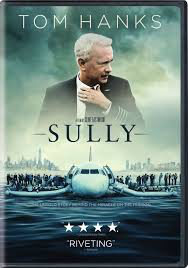 Here are the facts surrounding the flight. In 2009, US Airways was still a large independent airline prior to merging with American Airlines in 2015. In its fleet of over three hundred mainline airliners were better than 250 Airbus A320s, split among the base model A320, plus smaller or larger variants. This was part of a highly successful line of two-engine aircraft built by the European manufacturer Airbus.
Here are the facts surrounding the flight. In 2009, US Airways was still a large independent airline prior to merging with American Airlines in 2015. In its fleet of over three hundred mainline airliners were better than 250 Airbus A320s, split among the base model A320, plus smaller or larger variants. This was part of a highly successful line of two-engine aircraft built by the European manufacturer Airbus.
The plane that day, an Airbus A320, was set to depart LaGuardia Airport in New York City at roughly half-past three the afternoon of January 15, destined for Charlotte, North Carolina. The outside temperature was 20°F, while area waters were just above freezing. Clearly, it was not a good day for an outdoor swim.
Captain Chesley “Sully” Sullenberger sat in the left-side seat, while first officer Jeffrey B. Skiles sat to his right, with Skiles slated to fly this leg of the journey. The plane lifted off uneventfully, turning northwest. As it neared 3,000 feet, the A320 struck a flock of large Canada geese, some of which were ingested into the two engines. The collision resulted in a full loss of power. Coming at such a low altitude over a major city filled with skyscrapers, the situation was critical.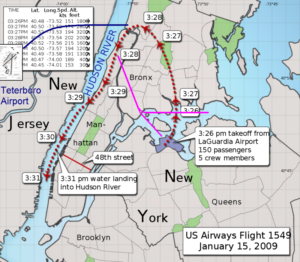
To provide some backup power, Sullenberger switched on the tail-mounted APU, a generator that provides auxiliary power. The pilots had only seconds to decide whether to return to LaGuardia, try to reach Teterboro Airport on the New Jersey side of the Hudson River, or find some alternative. Drawing on his vast experience, Sullenberger determined that trying to reach either airport was a poor choice, so he opted to land on the calm winter waters of the Hudson.
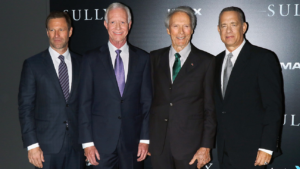
First Officer Eckhart, Capt. Sullenberger, Eastwood and Hanks
Sullenberger had informed air traffic control at LaGuardia of their predicament, and controller Patrick Harten cleared a runway for the stricken plane. Sullenberger’s terse response, however, was “Unable.” When offered the opportunity to head south to New Jersey, Sullenberger answered, “We can’t do it . . . We’re gonna be in the Hudson.” Passing less than 900 feet over the George Washington Bridge, the plane landed safely in the middle of the Hudson, where all passengers and crew were rescued by nearby boats.
What is so wonderful about the film Sully is the fact that it is so true to real life. Unlike so, so many other “reenactment” and “based on” films and documentaries, Eastwood’s Sully panders not at all to liberal pieties, not even in minor roles such as an air traffic controller or the captain of a ferry boat. We don’t have the cheesy cabin ensemble of multiracial passengers, something ushered in by the likes of Airport 75 and other such dreck from the seventies. Sully is like the cast of The Waltons, imagined as if John-Boy* had grown up and become a pilot like Sullenberger. No drinking, no drugs, no wild sex. Just traditional White Americans living their lives and dealing with the challenges life inevitably throws our way.
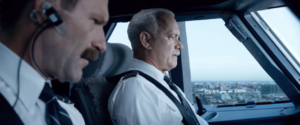
Surprisingly, despite its debut during the run-up to the Hillary-for-President season, the same press that so blatantly supported Hillary and savaged Trump as “literally Hitler” gave Sully overwhelmingly positive reviews. For instance, reviewer Simon Thompson awarded the film nine out of ten points, writing: “Sully is a beautifully balanced, classily nuanced and hugely engaging film that avoids all the clichéd pitfalls it could have slipped into [like pandering to diversity?]. Tom Hanks gives one of the best performances of his career and Clint Eastwood’s direction is beautiful and rich. It’s not just a great movie, Sully is one of the best pieces of cinema that a major Hollywood studio has released this year.”
A reviewer at ebert.com wrote:
As Capt. Chesley “Sully” Sullenberger, the plain-spoken, cool-headed veteran pilot who pulled off the impossible under immense pressure, Tom Hanks once again reminds us why he continues to be Hollywood’s best personification of the all-American Everyman since James Stewart’s Mr. Smith Goes to Washington. Who else is so good at encapsulating such red-White-and-blue values as never-say-die commitment, pride in a job well done, doing your duty no matter the cost and selfless courage in the face of disaster without being a goody-goody bore?
Even the Village Voice said kind things about the film, despite being aware of the obvious racial message: “This is a talky, mild-mannered drama about stoic, middle-aged White men exhibiting poise amid chaos and illustrating the sanctity of simply doing one’s job.”
Of course, these reviewers are right about the roles Tom Hanks generally accepts. Consider the likes of Apollo 13 with its all-White cast, or Saving Private Ryan, Cast Away and Captain Phillips — again almost completely White films. While Forrest Gump may have had Bubba as a major character, the saga was still an overwhelmingly White story.
What about Philadelphia, though? Perhaps we can forgive Hanks for his lead role in that film, with its shameless propaganda arguing for the pure innocence of homosexual men in the time of AIDS, and blaming, of course, a bigoted White patriarchy. In the early nineties, this kind of genuflection to liberal sensibilities was no doubt a good step to take, so Hanks took it. Nobody’s perfect.
Besides its welcome pro-White male footing, Sully also serves as an antidote to the trauma of 9/11. In events of that day, the planes came in, the towers went down, and a lot of innocent people died. In Sully, we see similar imagery as well, as noted by this reviewer for TIME Magazine:
The calamity of 9/11, though it occurred eight years prior to the events of Sully, haunts the movie, rightly: The image of an aircraft coming in low along the skyline of New Jersey was all too reminiscent of the day the towers came down; Eastwood seems to take great care not to create any shot that directly resembles the images we all have of 9/11, but the memory of that day is reflected in the eyes of random characters, as Sully negotiates the George Washington Bridge and the West Side of Manhattan and comes to rest splashily atop the frigid waters of the Hudson.
Fortunately the images of planes crashing into New York high-rises are only nightmares, bad dreams which people can shake off upon waking. In the real world of Sully, people live.
Come to think of it, there is another amazing thing about Sully: Despite taking place in one of the most Jewish locations on the planet, the movie is totally free of any Jewish storyline. No concocted drama about Jewish passengers. No side story about Jewish reporters exhibiting heroism on the Hudson. No Mighty Jew organizing all the rescue teams. How did Eastwood and the producers get away with that?
It’s been my job for many years to highlight and unpack Jewish power in Hollywood and media more general, plus I’ve been very attentive to endless multicultural attempts to replace White American males with the “Numinous Negro,” most tellingly with Morgan Freeman (beginning well after he got done playing Count Dracula on The Electric Company) and Denzel Washington.
In fact, among my many discussions of Washington’s roles was five years ago where Washington appeared as crack pilot “Whip” Whitaker in Flight. I wrote a consideration of the film (Part I & Part II) before I’d had the chance to watch it. As advertised, Whitaker performs feats of flying few others can manage, but director Robert Zemeckis ended up giving us a far more complex character, one complete with serious flaws beginning, but not ending, with drinking while flying, snorting cocaine before flights, and regularly rodgering a flight attendant despite being married.
In my view, Sully is a welcome counter to any image of a mythical Black pilot performing superhuman maneuvers aloft. It also counters attempts by the likes of the 1995 HBO film The Tuskegee Airmen to elevate a historical footnote into a major role in World War II. And George Lucas’s personal $50 million funding of a film about these same pilots in Red Tails did not result in a success. In fact, the film failed to recoup its investment.
More recently, we’ve had the ludicrous attempt to attribute the success of the Apollo space program to some unheralded Black women mathematicians. Called Hidden Figures, the 2016 film may be considered a going-away present for Obama, another black figure who accomplished so little. Leave it to Paul Kersey to pick this fantasy film to pieces, as he did in “Hyped Figures: John Glenn And The PC Myth Of Katherine Johnson–Unsung Black Women Were NOT What Got Us To The Moon.”
As a bit of an aside, I’d like to run a bit with stories about real Blacks in the cockpit. I don’t mean to pick on Blacks — after all, they have precious little to do with the images Hollywood uses them for. In real life, it hasn’t always been pleasant when Blacks have entered the normally White sanctuary of a flying machine.
Take this example. Much to my amazement, Cineflex, which produces the popular “Mayday” series of airplane crash reenactments, came out with an episode called “FedEx Flight 705 — Fight for Your Life. (This URL currently gives you the show.). This true story details the events surrounding the 1994 cockpit attack by a suicidal Black pilot on three White men flying the plane. Auburn Calloway was a rare Black pilot, but he faced growing threats to his career. At the end of his rope, he hatched a plan to hijack a FedEx DC-10 by killing the flight crew, then turn the massive jet back to its Memphis base and crash the plane into the FedEx headquarters.
Riding that day’s flight as a non-flying employee, Calloway brought hammers, a knife and a spear gun aboard, thinking the blunt-trauma injuries would mimic those incurred in a crash. Half an hour into the flight, as the crew exchanged small talk, Calloway launched his frenzied attack on pilots Sanders and Tucker, and flight engineer Peterson. The suddenness of the attack is evident from the sounds captured by the cockpit voice recorder:
DS = pilot Sanders
JT = co-pilot Tucker
P = flight engineer Peterson
AC = attacker Calloway
AW = autowarning
JT: Do you, uh, live over in Arkansas, Dave, or . . . ?
DS: Naw, I live in Fisherville.
JT: Aw, Fisherville, great spot.
(Sounds of hammer blows striking pilots.)
AP: Ow!
JT: God! Oh, ah, shit.
DS: God almighty!
AP: Ow!
JT: What the f*ck are you doing?
DS: God, (groan), (groan), God almighty! God, God, God. . . .
JT: Get him, get him, get him
DS: He’s going to kill us.
JT: Get him!
DS: Get up, get him!
AP: I can’t, God!
UV: STOP! (unintelligible) Hold his goddamn . . .
AC: Sit down, sit down, get back in your seat, this is a real gun, I’ll kill ya.
JT: Get him, get him, get him, get him, get him, get him!
AW: bank angle, bank angle…
JT: Get him, get him, get him!
AC: I’m gonna kill you! Hey, hey! I’ll kill ya!
As with the “Miracle on the Hudson,” the White male flight crew succeeded against the odds in safely returning to earth.
Ironically, Sully Sullenberger himself investigated a crash in which a disgruntled Black former airline employee, David Burke, killed the White male pilots of a four-engine airliner, causing the plane to nosedive into a California field, killing all forty-three aboard. That was the December 7, 1987 Pacific Southwest Airlines Flight 1771, a story also featured in a Cineflex “Mayday” episode, which possibly can still be seen here. For what it’s worth, Wikipedia reports that Burke “was a suspect in a drug-smuggling ring that was bringing cocaine from Jamaica to Rochester via the airline. He was never officially charged and reportedly relocated to Los Angeles to avoid future suspicions. Some former girlfriends, neighbors, and law enforcement officials described him as a violent man before Flight 1771. He had seven children, but never married.”
Well, let’s get those bleak images out of our minds and instead dwell on the far happier story of Sully: Miracle on the Hudson. In an age where White males have been struggling against an organized onslaught, the fact that a film like Sully can be made AND a man like Donald Trump can become president is welcome news indeed. Now go out and get a copy of Sully . You’ll be glad you did.
*I mentioned “John-Boy” Walton above. For those interested, you can watch the appearance of actor Richard Thomas in a TV movie called Crash Landing: The Rescue of Flight 232 (also known as A Thousand Heroes, 1992). Thomas plays the role of a fireman at Sioux City Airport, the scene of the Summer of 1989 crash of a United Airlines DC-10. This true story is yet another honest portrayal of White men performing heroically. (Enjoy Charlton Heston as a pilot and James Coburn as the fire chief.) Try this link to watch the movie: https://www.youtube.com/watch?v=YTvkn7B20fo.





Comments are closed.